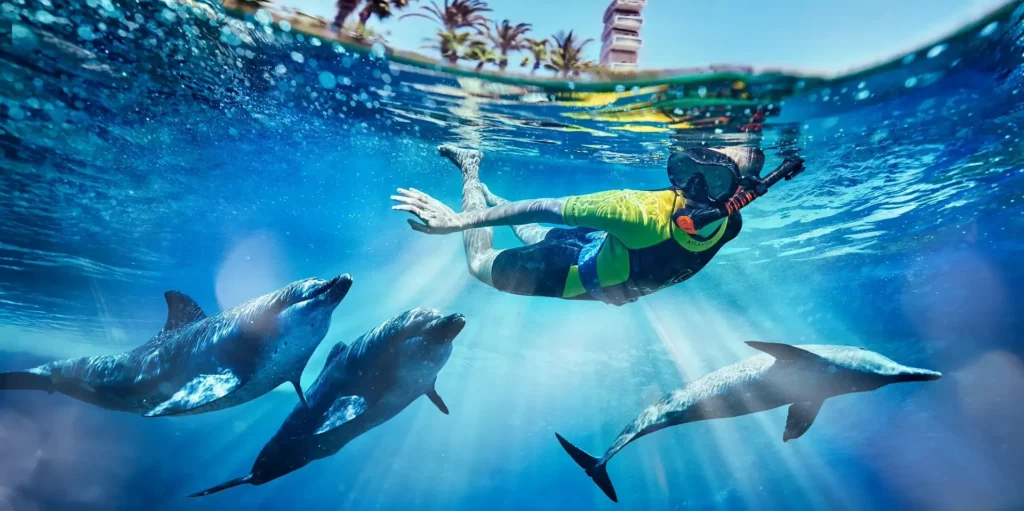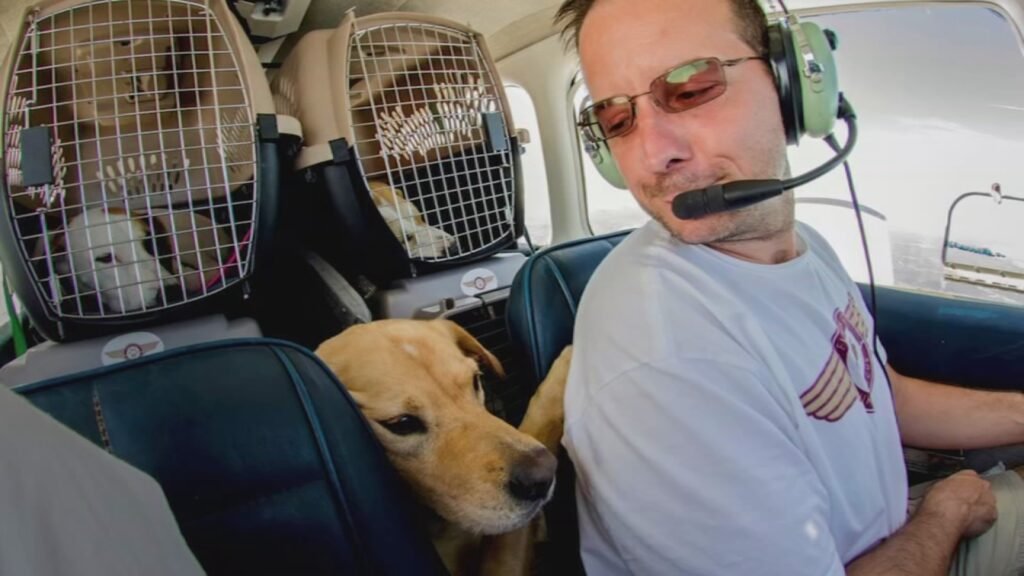Dolphins have long been symbols of freedom, intelligence, and joy. In the wild, these marine mammals roam vast stretches of ocean, traveling up to 40 miles a day, forming tight social bonds, and displaying remarkable problem-solving skills. Yet at many resorts and hotels across the world, these same animals are reduced to living in barren tanks, forced into repetitive shows and interactions with tourists for profit.
Animal welfare organizations, including In Defense of Animals (IDA) and PETA, have repeatedly sounded the alarm: dolphin captivity is harmful, unethical, and unnecessary. From cramped enclosures to abusive training practices, the evidence is overwhelming that dolphins suffer greatly when kept in captivity.
This Sustainable Action Now Report explores the major issues behind dolphin captivity at resorts, highlights facilities most criticized for poor conditions, and offers ethical alternatives for travelers who want to support dolphins without contributing to their suffering.
Why Dolphin Captivity Is So Harmful
The captivity of dolphins at resorts and hotels creates severe physical and psychological distress. Behind the picture-perfect advertisements of “swim-with-dolphins” programs lies a darker truth: animals are confined, manipulated, and often made to endure lives far removed from their natural state.
- Confinement and stress: In their natural environment, dolphins swim long distances, dive deep, and use echolocation to explore. In captivity, they are restricted to tanks that may be only a fraction of their natural range, leading to heightened aggression, listlessness, and even self-harming behaviors.
- Abuse for entertainment: Many facilities use food deprivation and operant conditioning to train dolphins to perform tricks or interact with tourists. These unnatural displays are designed solely for entertainment, not animal welfare.
- Poor tank conditions: Captive tanks often lack sufficient depth, shade, or clean water. Prolonged exposure to direct sunlight leads to sunburns, blistering, and eye problems—conditions that dolphins in the wild can naturally avoid.
- Disrupted breeding and family bonds: Captive breeding programs frequently involve separating calves from their mothers prematurely to create more dolphins for profit. This causes immense distress in animals known for their strong familial and social ties.
- High mortality rates: According to reports from PETA and other organizations, dolphin mortality rates at facilities like SeaWorld and the Mirage Hotel & Casino remain disturbingly high, with causes ranging from infections to aggression between stressed animals.
Resorts and Hotels Under Fire
Several well-known resorts and attractions have faced criticism from advocacy organizations for their dolphin programs. These facilities have become prime examples of how captivity can harm dolphins despite being marketed as luxury or family-friendly experiences.
- Barceló Maya Grand Resort (Mexico)
A Dolphinaris facility at this resort has been flagged by UrgentSeas for maintaining one of the smallest dolphin enclosures in Latin America. Tanks reportedly measured only two meters deep, offering no escape from the blazing sun, which contributed to eye damage and skin problems. - Mirage Hotel & Casino (Nevada)
While the Mirage’s Secret Garden and Dolphin Habitat has since closed, its legacy remains controversial. High dolphin mortality rates under the scorching Las Vegas sun made the facility a long-standing target of animal rights campaigns. - Discovery Cove (Florida)
Owned by SeaWorld, Discovery Cove continues to market up-close dolphin encounters despite the company’s troubled history of animal welfare violations. PETA and other groups have protested against SeaWorld’s treatment of marine animals for decades. - Dolphin Quest (Hawaii)
Located at the Kahala Hotel & Resort and Hilton Waikoloa Village, Dolphin Quest promotes interactive dolphin programs that critics argue exploit animals for entertainment rather than education or conservation. - Hawks Cay Resort (Florida)
This Florida Keys destination partners with Dolphin Connection, where tourists swim with captive dolphins. Animal rights groups, including PETA, have condemned the practice as cruel and unnecessary.
Ethical Alternatives for Responsible Travelers
The demand for dolphin encounters at resorts perpetuates the cycle of captivity. Fortunately, travelers have the power to make ethical choices that both support dolphins and promote conservation. Instead of paying for captive experiences, consider these humane alternatives:
- Responsible dolphin-watching tours: Observing dolphins in their natural habitat is an unforgettable experience when done responsibly. Tours that follow strict guidelines ensure that animals are not disturbed while offering travelers a genuine look at dolphins’ natural behaviors.
- Marine rehabilitation centers: These facilities rescue, rehabilitate, and release injured or stranded dolphins and other marine animals. Unlike entertainment-driven resorts, they prioritize animal welfare and conservation.
- Support advocacy organizations: Groups like the Dolphin Project and Whale and Dolphin Conservation work tirelessly to end the global trade in captive dolphins and protect wild populations. Supporting their work directly helps dismantle the demand for dolphin exploitation.
For more stories and insights on protecting marine life, visit the Dolphin Outlook section of Sustainable Action Now.
Why Ending Dolphin Captivity Matters
Every dolphin in captivity is a reminder of how far we have to go in ensuring humane treatment of animals. Resorts and hotels that exploit dolphins for entertainment perpetuate suffering, mislead tourists about animal welfare, and divert attention from meaningful conservation efforts.
By speaking out, raising awareness, and choosing ethical alternatives, travelers can help shift the industry away from cruelty and toward compassion. Dolphins belong in the ocean—not in tanks. Their freedom, health, and happiness depend on us making better choices.
Top 10 Ethical Dolphin Experiences Around the World
For decades, dolphins have been exploited in the name of entertainment. Resorts and marine parks profit from captive encounters that leave these intelligent beings confined, stressed, and far removed from their natural lives. But there’s good news: travelers no longer have to choose between unforgettable experiences and compassion. Around the world, there are safe, ethical ways to connect with dolphins—without supporting captivity.
Here are 10 ethical dolphin experiences that put animal welfare first.
1. Dolphin Watching Tours in the Azores, Portugal
The Azores are one of Europe’s best-kept wildlife secrets. Local operators follow strict eco-guidelines, ensuring dolphins are never chased or harassed. Visitors can watch pods in their natural habitat, often alongside whales, seabirds, and other marine life.
2. Kaikōura, New Zealand
This small town on New Zealand’s South Island is world-famous for its marine biodiversity. Dolphin-watching tours here are highly regulated, balancing tourism with conservation. You may spot dusky dolphins leaping through the waves in large, playful pods.
3. Bimini, The Bahamas
The shallow turquoise waters of Bimini are home to wild Atlantic spotted dolphins. Eco-tour companies in the region prioritize respectful observation, allowing travelers to witness these animals in a pristine environment.
4. Sataya Reef, Red Sea, Egypt
Also called Dolphin House, this reef is a hotspot for spinner dolphins. Local conservation-focused tours let visitors snorkel nearby while ensuring animals are not disturbed—a rare opportunity to coexist with dolphins in their natural home.
5. Moray Firth, Scotland
Bottlenose dolphins thrive off the coast of Scotland’s Moray Firth. Land-based watching platforms and boat tours with eco-certifications give visitors a chance to spot dolphins while minimizing human impact on the fragile marine ecosystem.
6. Tarifa, Spain
Tarifa, the southernmost point of continental Europe, is a prime location to see dolphins and whales migrating between the Mediterranean and the Atlantic. Eco-operators in the area are committed to responsible wildlife watching practices.
7. Monkey Mia, Western Australia
At Monkey Mia, wild dolphins have visited the shoreline for decades. Strict guidelines prevent overexploitation, with only a handful of dolphins occasionally interacting under the watch of rangers. The experience educates visitors while keeping the dolphins wild.
8. Osa Peninsula, Costa Rica
Costa Rica’s Osa Peninsula is a paradise for eco-tourism. Responsible dolphin-watching tours operate here in harmony with conservation efforts, giving travelers a chance to see spinner and bottlenose dolphins in lush tropical waters.
9. Vancouver Island, Canada
Off the coast of British Columbia, dolphin and whale watching is big business—but eco-certified operators ensure encounters remain safe and sustainable. Pacific white-sided dolphins are commonly spotted, often in impressive pods.
10. Supporting Marine Sanctuaries & Rehabilitation Centers
If travel isn’t an option, supporting sanctuaries that focus on rescue, rehabilitation, and release is one of the best ways to help dolphins. Organizations like the Dolphin Project, Whale and Dolphin Conservation, and local marine rescue centers worldwide give dolphins a second chance at freedom.
Travel With Compassion
Choosing ethical dolphin experiences means refusing to support captivity and exploitation. By supporting responsible tours and sanctuaries, travelers can enjoy life-changing encounters while helping to protect dolphins where they belong—in the wild.
For more updates on protecting dolphins and other marine life, visit the Dolphin Outlook section of Sustainable Action Now.


